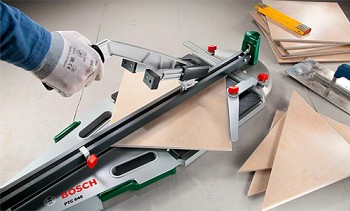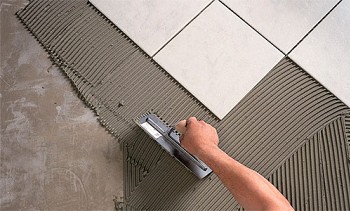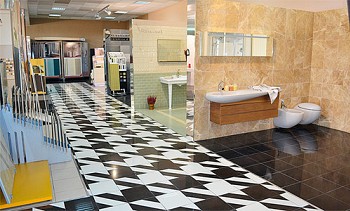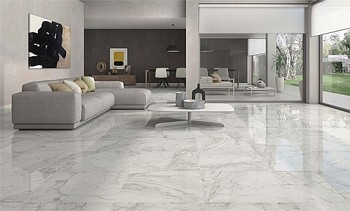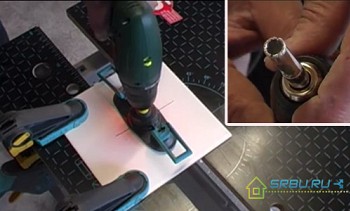How porcelain tiles differ from ceramic tiles
Porcelain tile (gres porcellanato) - one of types of facing ceramics. Like any ceramics, it is produced by sintering a mixture where clay, quartz sand and feldspar are the main components. However, in the technology of its production there are differences that, although they are not of a fundamental nature, have created a colossal difference between porcelain stoneware and ordinary ceramic tiles, which gives reason to consider it a completely special material. Consider these differences and, perhaps, dispel some of the misconceptions and myths associated with tiled gres.
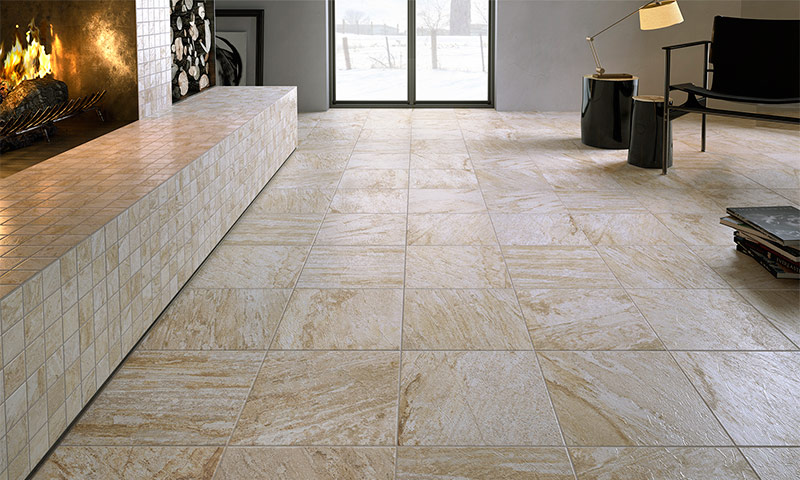
Content:
The difference in the production of porcelain tiles and ceramic tiles
Before discussing how ceramic granite differs from ceramic tile, it is worth familiarizing yourself with the features of the production of these materials.
The production of ceramic products is based on clay firing processes in conjunction with quartz and feldspars. The technological chain of manufacture of any ceramics looks like this:
- grinding of the starting components and their dosing, preparation of the mixture;
- molding of products - by molding, pressing or extrusion;
- drying - removal of physically bound water;
- burning.
If necessary, glaze is applied to the surface of the biscuit before firing. Glaze can be applied after the main firing, in which case the product is fired once more. When applying a complex multilayer decor, multiple firing is used, necessary for the formation of glaze.
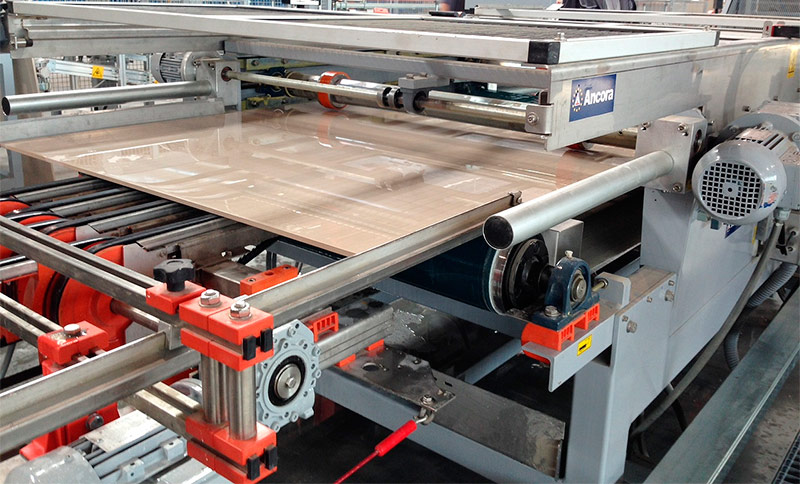
Feedstock
Differences in porcelain tile begin with the composition of the raw materials. For ordinary ceramics, red and white clays are used, and for porcelain stoneware - white-burning kaolin and illite. Pore-forming additives are introduced into conventional ceramics, which reduce the mass of products. In the case of porcelain, they are not added, which contributes to the production of a dense shard. An important role in the mixture for porcelain tiles is played by surface-active substances (surfactants), which reduce internal friction in the charge and facilitate its compaction when molding products.
Porcelain tile has nothing to do with natural granite. This name was used by Mirage, which first introduced this material on the Russian market. The name stuck due to its strength and the characteristic granular pattern that was on the first series of products.
Molding
For molding porcelain products, the method of dry and semi-dry pressing is used. The main difference is the high pressure reaching 500 kg / cm2. For other types of ceramics, the pressing pressure usually does not exceed 400 kg / cm2. At this pressure, not only is the charge compacted, but also the deformation of its constituent particles, their destruction, “indenting” them into the total volume and the elimination of voids.
The pressing process is divided into two stages. The first is a preliminary compaction of the mixture. Subsequent pressure relief allows you to remove the air squeezed out of the charge, and the second stage of pressing completes the process and creates a biscuit, which retains its shape due to surface tension forces and a large contact surface of the grains.
Drying is a mandatory step, since excess moisture with strong heating violates the integrity of the shard.
Burning
The firing of gres tiles is characterized by high temperature. Ordinary ceramics are fired at 950–11800C. Sintering temperature of porcelain tiles reaches 1250–13000FROM.
The temperature rises gradually, since with its increase at each stage certain processes occur, which are important for obtaining ceramics:
1. 2000C - evaporation of residual moisture.
2. 300—4000C - burnout of organics.
3. 5000C and above - dehydration of kaolinite and other minerals contained in clay.
4. 700–8000C - afterburning of coke residues.
5. 830—8500C is the decomposition of clay materials into oxides with the formation of silica and alumina.
6. 920—9800C is the beginning of the formation of mullite, which increases at 1100-12000С.
Mullite is a mineral that, together with quartz, provides hardness of porcelain stoneware.
In addition to chemical reactions, a whole complex of physical transformations takes place — melting of some components and dissolution of others in them, formation and removal of the gas phase, and crystallization of new compounds. These processes continue when the product cools, which is no less important than heating, and occurs with a strict schedule.
So, the manufacturing technology of porcelain tiles is distinguished by the selection of raw materials, high pressure during molding and high firing temperature.
Next, we consider the differences in the finished material, which are determined by the characteristics of production.
General characteristics
Pressing under high pressure, the features of raw materials and firing give the porcelain tile a high density. The shard has virtually no pores, and the bulk density of the material is about 2400 - 2600 kg / m3. For comparison: the density of most types of tiles is 1600 - 2000 kg / m3.
Density says little about the consumer qualities of the material. The ability to absorb water is more informative. This property characterizes the structural density of ceramics. The most important operational parameters of the cladding are closely connected with it - strength, wear resistance, frost resistance.
Water absorption of porcelain stoneware does not exceed 0.5% by weight. Some manufacturers claim this parameter at the level of 0.1%, and in the most dense samples it reaches 0.05%. Most types of ceramic tiles have water absorption in the range of 3 - 10%.
Low porosity gives a quality that is important for finishing, especially for flooring. It is stain resistant. Most household, and not only household pollutants are easily removed from the surface of porcelain stoneware with a stream of warm water.
Strength
The concept of strength in relation to ceramic tiles is determined by three parameters:
- bending strength;
- impact strength;
- surface hardness.
According to GOST 6787-2001, ceramic plates for the floor must have a bending strength of at least 25 MPa. For wall cladding, the requirement is significantly lower - 15 MPa. The ultimate tensile strength of porcelain stoneware is 40–49 MPa. In practice, this means that you can not be afraid of breaking a gras tile by accidentally pressing it when working with it. As a rule, these products remain intact, even if you inadvertently step on a plate left in place. The usual tile at the same time, most likely, will crack.
Impact strength is not standardized by the technical conditions for the production of tiles, so it is difficult to make the correct numerical comparison for this parameter. But from practice it is known that gres tiles remain intact in situations where tiles are guaranteed to break. Impact resistance is especially valuable for flooring.
The hardness of ceramics is usually measured in points on the Mohs scale. This scale is based on ten minerals selected as reference. Talc and graphite have one point on this scale. Ten is a diamond. Porcelain on this scale is located on the same level with quartz - seven points. It can not be scratched with a knife, glass, file. Quartz can hardly leave a mark on it. The most durable porcelain stoneware samples achieve a topaz hardness of eight points.
Ordinary ceramics on the Mohs scale get 4-6 points. According to GOST, the hardness of the facing tile is not standardized at all, it only has a requirement for a glazed surface - not less than 5 points according to Mohs.
Wear resistance
Abrasion resistance of materials is characterized by abrasion. Abrasion is determined by testing the sample with an abrasive tool under strictly defined conditions. The numerical value of abrasion is equal to the decrease in mass of the sample after the test cycle.In practice, to indicate wear resistance, division of the facing tile into classes is applied according to its applicability depending on the load.
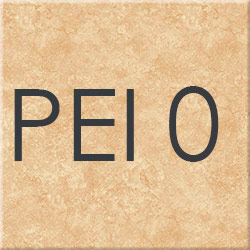
PEI-0 - minimum durability. Tiles of this class are applicable only for wall cladding.
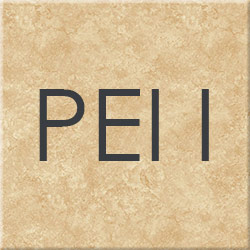
PEI-I - products of this class can be used for walls and floors of bathrooms, bedrooms and other rooms where there are few people in soft shoes or barefoot.
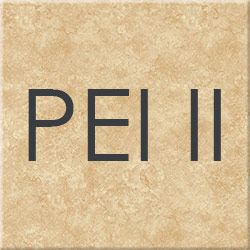
PEI-II - cladding applicable to the floor of residential premises, except for the kitchen and hallway.
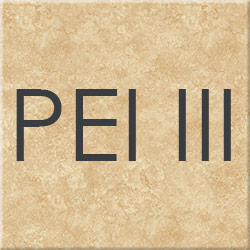
PEI-III - Wear-resistant lining, which can be used for any premises that do not have direct access to the street. Suitable for small offices.

PEI-IV - tiles with which you can cover the floors of residential premises, kitchens, hallways, terraces. It can withstand the load on the floor of an office, hotel or small store.
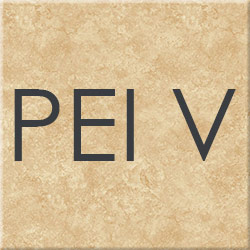
PEI-V - flooring for public areas with high intensity of use: stations and airports, large shops and entertainment centers.
The wear resistance of most ceramic tiles is mainly determined by the hardness of the coating that covers them; this is the maximum grade of PE-IV. Unglazed porcelain tile belongs to the class PE-V and can withstand any load.
Increased impact strength, hardness and wear resistance - this is, most importantly, the difference between porcelain tiles and floor tiles of the usual type. These are qualities that significantly expand the scope of ceramic cladding.
Frost resistance
Frost resistance is the ability of materials to withstand repeated temperature changes from “-” to “+” Celsius. This property is important for the external cladding - terrace, balcony, porch, basement or facade of the building. Freezing followed by thawing results in frosty destruction of products. The destructive factor is the water contained in the pores and capillaries of the material. When freezing, it expands and creates tearing loads.
According to GOST 27180-2001, the frost test is performed by repeated cooling of a sample saturated with water to -15 ..- 200C followed by warming in warm water to +15 .. + 20 0C. Conventional ceramic tiles can withstand 25 to 125 cycles (F25 - F125), gres boards have frost resistance F100 - F300 (up to 300 cycles).
Porcelain tile can be used without limitation for facing any surfaces subject to moisture and low temperature. One of the most common applications is the curtain wall systems.
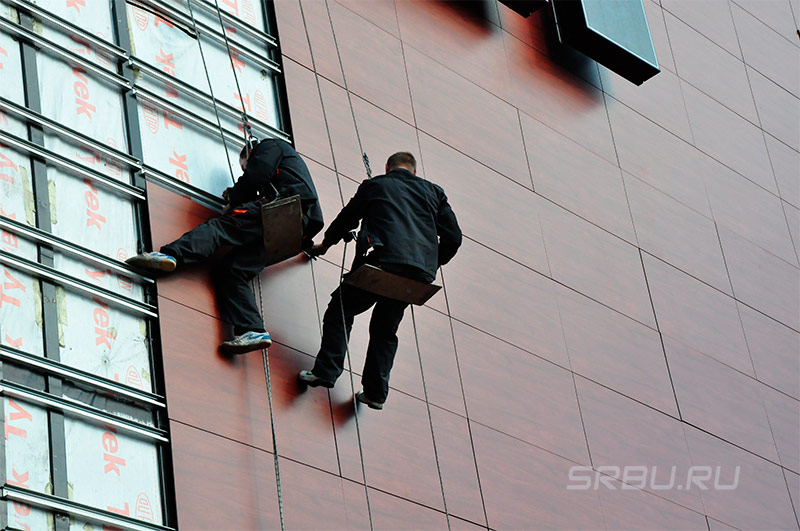
The reason for the high frost resistance of porcelain stoneware is its low water absorption: there are very few pores, water is not absorbed, and there is no frost damage.
Appearance
When decorating ceramic cladding, another difference between porcelain stoneware and ceramic tiles is manifested. Glazing ordinary tiles creates the hardest, strongest and most waterproof layer on its surface. The performance of the cladding is enhanced. Glazing the tiles gives great opportunities for the implementation of a variety of design solutions.
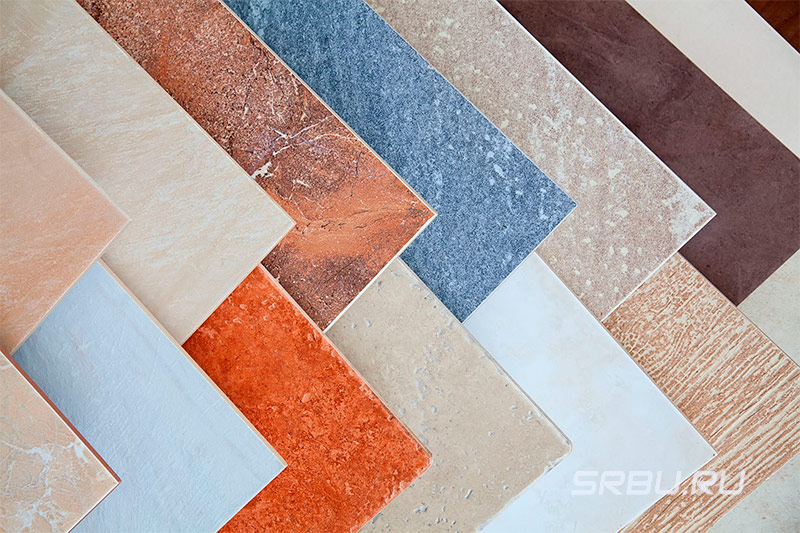
For porcelain stoneware, such a decor means lowering all parameters except aesthetics! This material is stronger, harder and more wear resistant than glaze. Therefore, glazed porcelain tiles are little used for public buildings, and only for cases of low load.
In addition to glaze, for decorating porcelain tiles use:
- staining in bulk;
- creation of a decorative layer by double filling of the charge when forming plates;
- embossed surface texture;
- polishing;
- lappating;
- satin finish.
Now more about each of the methods.
Bulk staining
To add color to the mixture, mineral pigments are added. Commonly used are dyes based on metal oxides:
- iron gives red tones, from yellow to brown;
- copper - red, emerald, green;
- zinc is white;
- cobalt is blue;
- chrome green;
- Manganese is purple.
Mineral dyes do not fade, do not fade, always maintain the desired tone. Tiles painted in bulk retain their color under any wear.
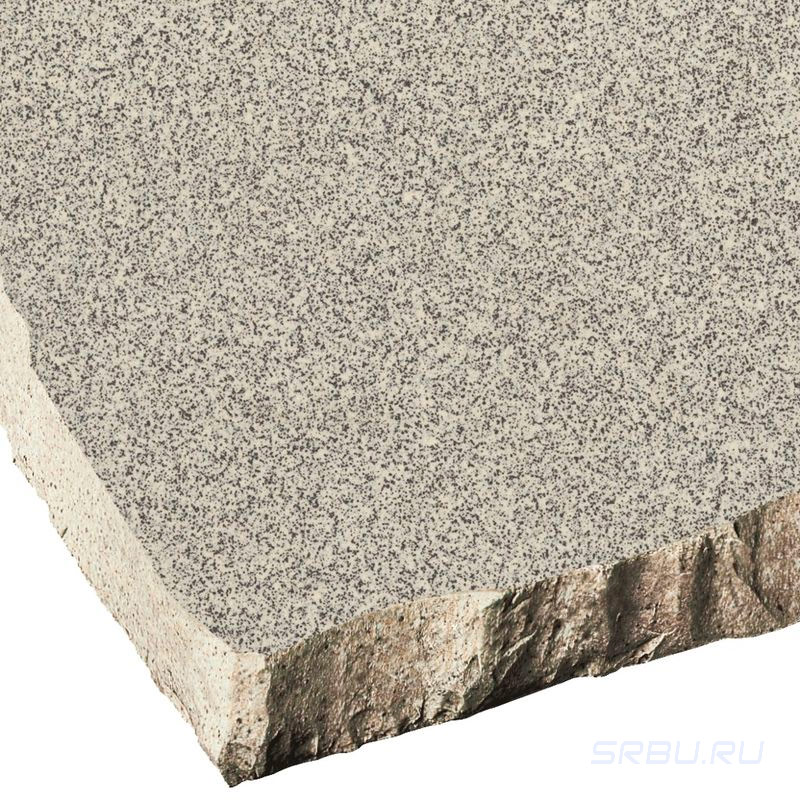
Double backfill
Two-layer filling of the charge is a technique that expands the possibilities of decorating porcelain stoneware.First, the main body of the tile is formed, then a mixture containing pigments is laid on it. Laying the decorative layer can be done with the formation of colored patterns.
After firing, a shard is obtained that is uniform in its physical properties, but having a decorative layer about 3 mm thick. Given the wear resistance of porcelain stoneware, this decor can be considered almost eternal, not subject to wear.
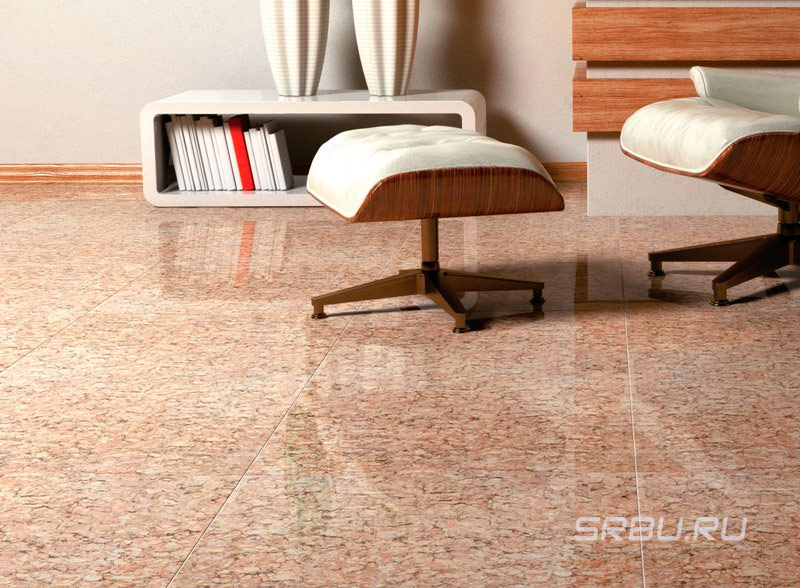
Relief
The relief on the surface of the plates is created during their molding, due to the special shape of the pressing mandrel. This creates a texture that mimics the mosaic, the structure of wild stone, wood. The choice of possible textures is not limited by anything. You can create any patterns or effects, for example, the effect of drops on the glass, which will be enhanced by subsequent polishing.
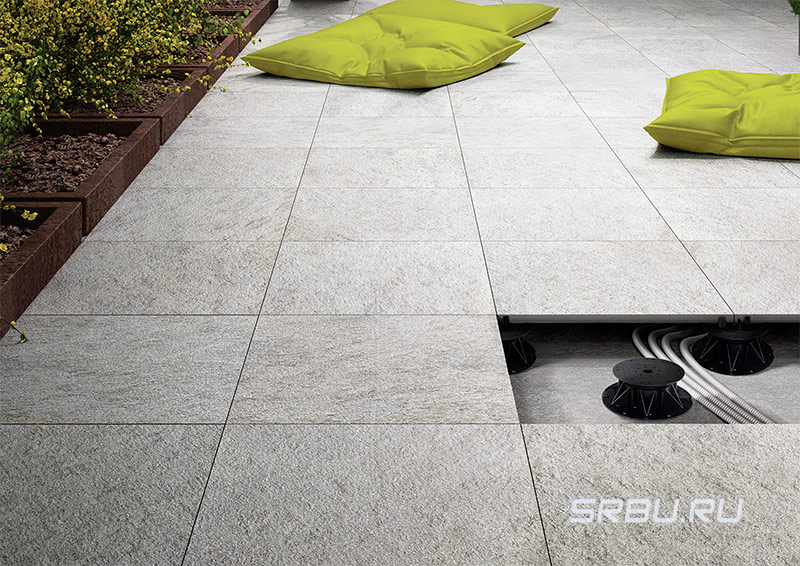
Polishing
Porcelain tile immediately after firing has a matte, rough surface. Polishing allows you to give it any degree of cleanliness, right down to the mirror. Mirror cladding is less resistant to wear, as abrasive treatment violates the surface structure of the material, and any scratches on a smooth surface are more noticeable.
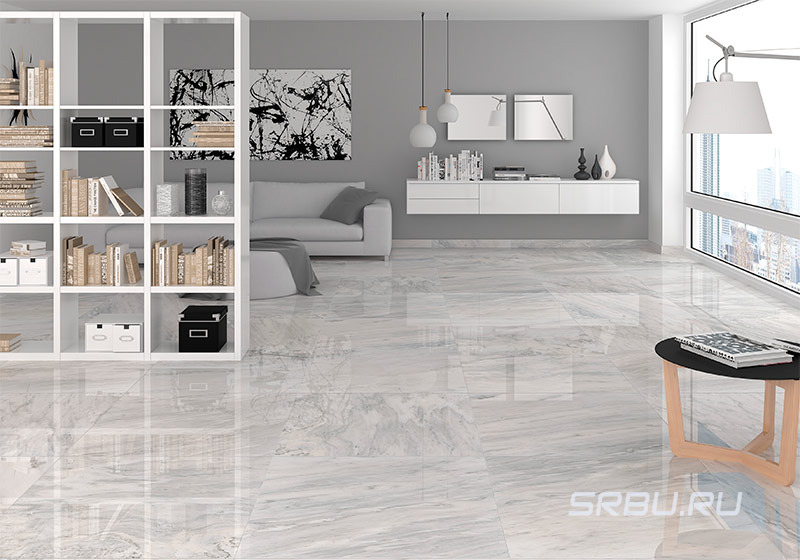
Lapping
So called partial polishing. Initially, products designed for lapping have a slightly uneven surface. Polishing with a flat tool reveals these irregularities, turns the protrusions into mirror sections without affecting the depressions. The difference in height is measured by microns, but this is enough to have a fascinating pattern of glossy and matte spots on the tile.
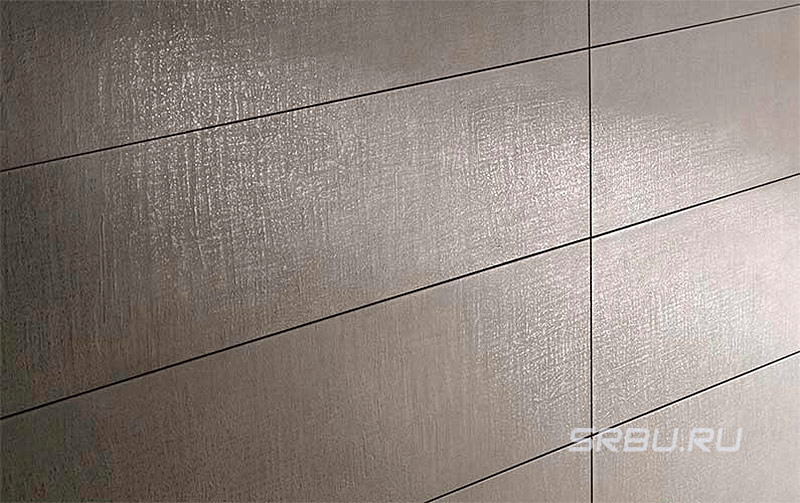
Satin finish
This is to obtain a smooth, but not a mirror surface by processing the plates before firing with special compounds. Satin tile has a soft “satin” shine, smooth to the touch, but not slippery.
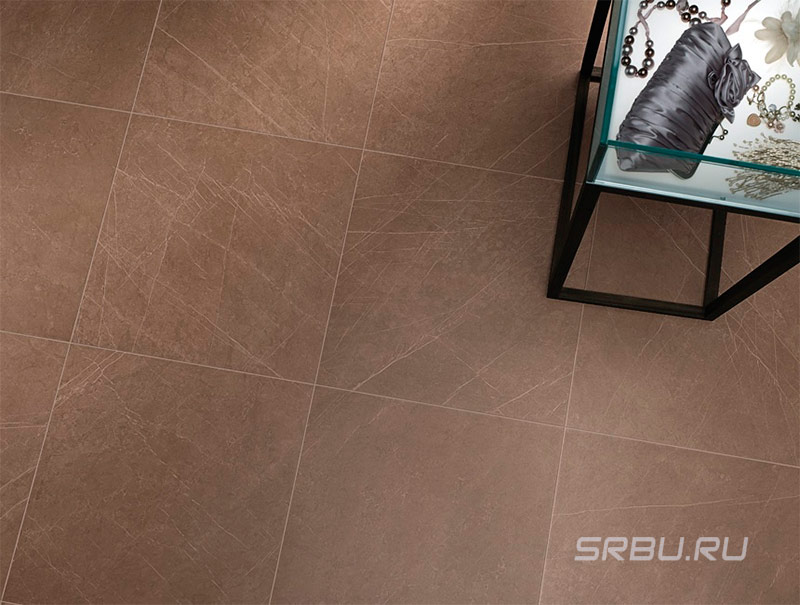
Comparison of porcelain stoneware and ceramic tiles according to the main parameters
To compile the comparison table, we used data on the technical characteristics of porcelain stoneware and ceramic tiles of various manufacturers.
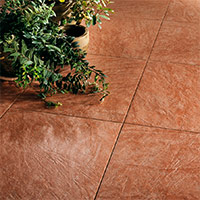 | 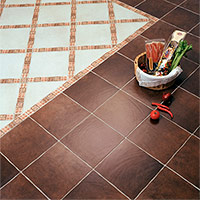 | |||||||
|---|---|---|---|---|---|---|---|---|
| Porcelain Tiles | Outdoor ceramic tile |
|||||||
| Water absorption,% | 0,05 - 0,1 | 3 - 6 | ||||||
| Bending strength, kg / cm. | 470 - 600 | 360 - 450 | ||||||
| Surface density according to the MEP scale | 7 - 8 | 4 - 6 | ||||||
| The degree of wear resistance P.E.I. | V | II - IV | ||||||
| Frost resistance, number of cycles at temperature from -5 0C to +5 0FROM |
100 - 300 | 25 - 125 | ||||||
Porcelain is superior to conventional ceramics in all physical and technical parameters. In terms of decorative capabilities, these materials are approximately equal. When choosing a coating, one should take into account the higher cost of porcelain stoneware and the fact that its use requires a special tile adhesive, which costs about three times more expensive than tile adhesives.

